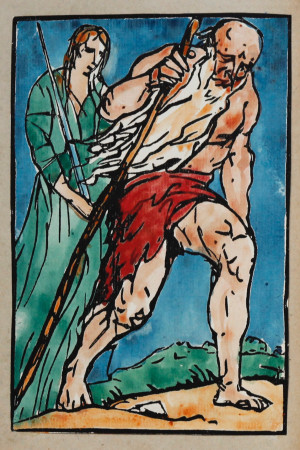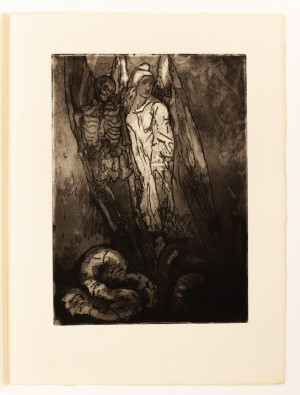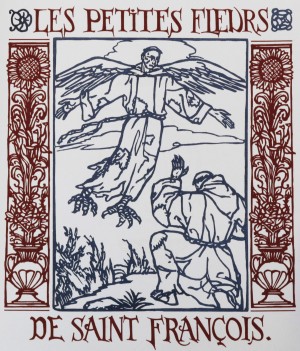Peter Bichsel Fine Books
| Bild | Titel | Beschreibung | Kauf |
|---|---|---|---|

|
Bernard, Emile. Le juif errant. Poème en vingt chants. |
Bernard, Emile. Bernard, Emile. Le juif errant. Poème en vingt chants.With 21 orig. hand-coloured wood-cuts by Emile Bernard, printed on china paper and mounted on plates. 290 pp. Small 4to. Red full morocco over 3 raised bands with gilt tooled illus. on front board. Orig. printed wrappers bound in. In matching slipcase. – Tonnerre, Michel-Ange Bernard, 1927 (on front wrapper: 1928). „La Divine Epopée“, vol. II. Unnumbered copy out of a total limited edition of 250, hand-printed in the years 1927/28 by Editions de la Rénovation Esthétique (M.-A. Bernard). The unique copy we could trace with hand-coloured woodcuts and with an extra suite of the cuts, here laid in an envelope bound-in at the end. Emile Bernard (1868–1941), friend of Paul Cèzanne, Vincent van Gogh and Paul Gauguin, wrote his present version of this famous legend during the war year 1914–1918. It was his son Michel-Ange who printed the text as well as the original cuts in 1927/28. The binding is a masterwork by the little known Zurich artist bookbinder Max Kaufmann, created in 1933 for a local collector Titus Vasella. Bookbinder’s invoice to Vasella laid in. – Fine copy, unique with the coloured cuts and the extra suite. – Best.-Nr. 20997 |
CHF 1900.— |

|
BERNARD. – Hugo, Victor. La fin de Satan. Edition du cinquantenaire. Cinquante eaux-fortes originales de Emile Bernard. |
Hugo, Victor. Bernard, Émile. La fin de Satan. Edition du cinquantenaire. Cinquante eaux-fortes originales de Emile Bernard.With engr. frontispiece and 49 orig. etchings on plates by E. Bernard, all protected by transparent paper with printed number and title. 219, (1) pp., 6 leaves. Large folio. Loose quires and plates as issued on orig. wrappers and half calf box with title on front cover and spine. – Paris, Le livre contemporain, 1935. One of 120 numbered copies on Vélin d’Arches spécial. Here no. 93 printed for Jacques André. Published in memory of the work of Victor Hugo and celebrating his fiftieth year of death. Emile Bernard (1868–1941) was member of the Nabis. His present etchings have the power and the beauty of Rouault’s religous illustrations. In particular: Plates no. 4 with the astonishing expression of Satan’s head, no. 17 with its impressive light and shadow, no. 35 with the opposition of Juda’s and Jesus’ head and no. 42 with Christ bearing the cross. The epic poem by Victor Hugo (1802–1885) ist one of his last texts and has never been fully achieved. It was first published posthumously in 1886. – Carteret IV, 208 (“Puissante illustration cotée“). – Bookplate on second flyleaf. Lower portion of cloth of box front cover torn off. Few plates or lieves with occasional foxing. Good to very good in all. – Best.-Nr. 25129 |
CHF 1800.— |

|
BERNARD. – Saint François (d’Assisi). Les petites fleurs. Traduction de Maurice Beaufreton. |
Franz von Assisi. Bernard, Émile. Les petites fleurs. Traduction de Maurice Beaufreton.With 2 illus. titles, 199 full-page illus. with bordures, 57 vignettes and 66 initials, all cut in wood by Emile Bernard and printed in bister and black. 416 pp, 8 unn leaves. Large 4to. Looser quires as issued in orig. illus. wrappers. – Paris, Ambroise Vollard, 1928. One of 350 numbered copies on Vergé d’Arches paper (+ 25 h.c.). The illustrations were printed by hand on the press of Marthe Fequet. Emile Bernard (1868–1941) was part of the Pont Aven circle around Gauguin. He is one of the main representative of Cloisonism and one of the founders of the French Symbolism. The astonishing illustrations to Saint François’ „Petites Fleurs“ were cut by himself into wood. – Carteret IV, 172 (“Belle édition recherchée et cotée“); Jentsch 18. – Spine ends of wrappers with some wear. Clean copy. – Best.-Nr. 20654 |
CHF 450.— |